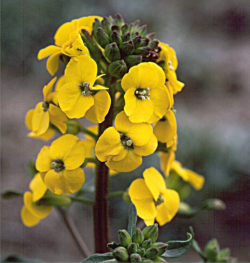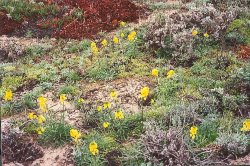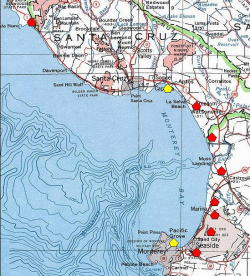
threatened

Photo taken at Marina Dunes Preserve © Dean W. Taylor.

Photo taken at Marina Dunes Preserve © Dean W. Taylor.

A red polygon indicates an extant occurrence; yellow indicates the occurrence has been extirpated.



This fact sheet was prepared by Grey F. Hayes, Dean W. Taylor, and Dylan M. Neubauer under award NA04N0S4200074 from the National Oceanic and Atmospheric Administration (NOAA), U.S. Department of Commerce (DOC). The statements, findings, conclusions, and recommendations are those of the authors and do not necessarily reflect the views of the NOAA or the DOC.
© Copyright 2006, Elkhorn Slough Coastal Training Program
Last updated: Jun 19, 2007 15:48
Common Names - coast wallflower
Family - Brassicaceae (Mustard Family)
State Status - none
Federal Status - none
Habitat
Coastal dunes, mostly in stabilized hind dunes; < 50 m.
Key Characteristics
Biennial or short-lived perennial herb, taprooted, stems to 9 dm tall; basal leaves rosetted, linear-oblanceolate, not at all fleshy, tapering gradually to broad margined petioles as long as the blades; inflorescence at first with the flowers dense and crowded (elongating in fruit), petals 14–24 mm long, claw 8–14 mm, brilliant yellow, style short and stout; siliques fleshy when immature, flattened when dry, fruit valve midvein prominent; seeds 50–86, oblong, tip, sides winged (Al-Shehbaz 2013).
Flowering Period
February to June
Reference Populations
Sunset State Beach (Santa Cruz County); Marina Dunes Preserve (Monterey County).
Global Distribution
Endemic to dunes flanking the Monterey Bay region of California (Santa Cruz, Monterey counties), and disjunct on the northern Channel Islands (Santa Rosa and San Miguel) (Santa Barbara County).
Conservation
Plants referred to E. ammophilum in San Diego County present a taxonomic issue and appear to represent two entities. Inland plants are better referable to E. capitatum var. capitatum (with seeds winged only at tip), however coastal plants do not fit well into E. capitatum or E. ammophilum. Study is needed (J. Rebman, pers. comm. 2015).
This species has been reported on Santa Rosa and San Miguel islands, but these plants also require taxonomic evaluation and may not be E. ammophilum sensu stricto. The northern-most documented station is at Año Nuevo, while the southerly station at Pacific Grove is now extirpated; it is now found no closer than the dunes at the Naval Postgraduate School.
In the Santa Cruz region, it is limited to a small area at Sunset State Beach (it probably did not ever occur along the Santa Cruz coast because of a lack of extensive dune habitat). At Marina State Beach, this species typically occupies dune scrub habitats that are generally more stable and inland compared to Menzies's wallflower (E. menziesii), but the two taxa do grow intermingled at Marina Dunes Preserve.
References
Al-Shehbaz, I. A. 2013. Erysimum ammophilum, in Jepson Flora Project (eds.). Jepson eFlora, http://ucjeps.berkeley.edu/cgi-bin/get_IJM.pl?tid=25109 [accessed 6 February 2015].
CNPS, Rare Plant Program. 2010. Erysimum ammophilum, in Inventory of Rare and Endangered Plants (online edition, v8-02). California Native Plant Society, Sacramento, CA. http://www.rareplants.cnps.org/detail/789.html [accessed 6 February 2015].
Rebman, J. Personal communication [8 February 2015].
